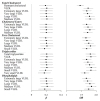Long-Term Exposure to Fine Particulate Matter and Incidence of Esophageal Cancer: A Prospective Study of 0.5 Million Chinese Adults
- PMID: 37059339
- PMCID: PMC7615725
- DOI: 10.1053/j.gastro.2023.03.233
Long-Term Exposure to Fine Particulate Matter and Incidence of Esophageal Cancer: A Prospective Study of 0.5 Million Chinese Adults
Abstract
Background & aims: Evidence is sparse and inconclusive on the association between long-term fine (≤2.5 μm) particulate matter (PM2.5) exposure and esophageal cancer. We aimed to assess the association of PM2.5 with esophageal cancer risk and compared the esophageal cancer risk attributable to PM2.5 exposure and other established risk factors.
Methods: This study included 510,125 participants without esophageal cancer at baseline from China Kadoorie Biobank. A high-resolution (1 × 1 km) satellite-based model was used to estimate PM2.5 exposure during the study period. Hazard ratios (HR) and 95% CIs of PM2.5 with esophageal cancer incidence were estimated using Cox proportional hazard model. Population attributable fractions for PM2.5 and other established risk factors were estimated.
Results: There was a linear concentration-response relationship between long-term PM2.5 exposure and esophageal cancer. For each 10-μg/m3 increase in PM2.5, the HR was 1.16 (95% CI, 1.04-1.30) for esophageal cancer incidence. Compared with the first quarter of PM2.5 exposure, participants in the highest quarter had a 1.32-fold higher risk for esophageal cancer, with an HR of 1.32 (95% CI, 1.01-1.72). The population attributable risk because of annual average PM2.5 concentration ≥35 μg/m3 was 23.3% (95% CI, 6.6%-40.0%), higher than the risks attributable to lifestyle risk factors.
Conclusions: This large prospective cohort study of Chinese adults found that long-term exposure to PM2.5 was associated with an elevated risk of esophageal cancer. With stringent air pollution mitigation measures in China, a large reduction in the esophageal cancer disease burden can be expected.
Keywords: Ambient Air Pollution; Digestive Tract; Malignant Tumor; Observational Study.
Copyright © 2023 The Authors. Published by Elsevier Inc. All rights reserved.
Figures



Comment in
-
Air pollution and oesophageal cancer risk.Nat Rev Gastroenterol Hepatol. 2023 Jun;20(6):344. doi: 10.1038/s41575-023-00786-z. Nat Rev Gastroenterol Hepatol. 2023. PMID: 37085615 No abstract available.
References
-
- Tian Y, Jiang C, Wang M, Cai R, Zhang Y, He Z, et al. BMI, leisure-time physical activity, and physical fitness in adults in China: results from a series of national surveys, 2000-14. Lancet Diabetes Endocrinol. 2016;4:487–497. - PubMed
-
- Bluher M. Obesity: global epidemiology and pathogenesis. Nat Rev Endocrinol. 2019;15:288–298. - PubMed
Publication types
MeSH terms
Substances
Grants and funding
LinkOut - more resources
Full Text Sources
Medical

